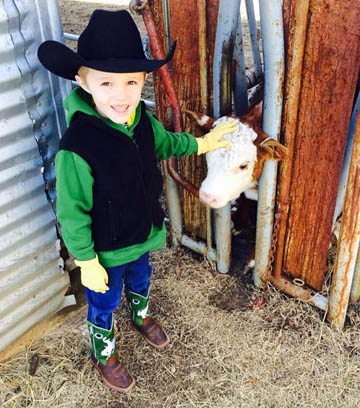Farm & Ranch
Let your babies grow up the be cowboys

By contributing writer Krista Lucas
People have heard the popular Winston Churchill saying, “There is something about the outside of a horse that is good for the inside of a man.” Horses and ranch life can shape a child in more positive ways than one.
Being involved with agriculture in any form can help the development of a child physically, emotionally and socially. Maturity can be gained through learning how to work with animals, as well as people.
Horses are used daily on a ranch, and many little boys and girls dream of having their own. An equine friend can be an instrumental tool in the development of a young child.
Jex Taylor, a four-year-old boy from Celina, Texas, has been around ranch life and horses his entire life by visiting his grandparents’ ranch.
He has learned how to brush, saddle and even ride a horse. His mom, Lindee Taylor, said his improvement in cognitive abilities such as language development was due to his involvement with horses.
“A speech therapist would constantly drill him with different labeled objects, but he wouldn’t interact,” Taylor said. “But when he started going to the barn, he was really interested every time.”
Horses helped Jex express himself. As a toddler, he rarely made any sounds, until he became involved with the horses and tractors on the ranch. He soon learned to make tractor noises and could name several horse breeds. To read more pick up the April 2014 issue of North Texas Farm & Ranch.
“He went from being almost nonverbal,” Taylor said, “to driving down the road and pointing out different types of horses.”
Jex became more observant by looking at horses and cattle, as well as wanting to communicate and be active on the ranch.
“He used to always want to sit in my lap everywhere,” Taylor said. “Now he wants to go to the barn.” When asked which horse is his favorite on the ranch, Jex replied, “Ace!”
“When he was three, every time I would ask, ‘What do you want for Christmas?’ he would say a horse,” Taylor said.
Ranch activities such as feeding cattle, including a 26-year-old longhorn, gave Jex the freedom to interact with others. Taylor said her son was excited to take a picture of the cow to show at his daycare.
Jex is just one of many boys and girls who have benefited from agriculture. Now there are even camps offered for children to participate in the rural way of life. There are therapeutic camps, riding lesson camps, and competitive rodeo camps.
Farm & Ranch
Managing Show Cattle Through The Winter

By Heather Welper
Husband and wife duo, Heather and Calvin Welper, are the Co-Owners and Operators or Two C Livestock, located in Valley View, Texas.
The pair’s operation has a show cattle focus where they raise and sell purebred heifers of all breeds and club calf Hereford steers.
When it comes to show cattle, the Welpers know a thing or two including how to prepare for the cold winter months and the Texas major show season run.
To read more, pick up a copy of the November edition of North Texas Farm & Ranch magazine, available digitally and in print. To subscribe by mail, call 940-872-5922.

Farm & Ranch
Double M Ranch & Rescue

By Hannah Claxton, Editor
As the sun rises each day, so do the dozens of mouths that Meghan McGovern is responsible for getting fed. Rather than the sounds of a rooster crowing, McGovern hears the bellows and bleats of a variety of exotic deer, the chortle of kangaroos, the grunts of water buffaloes, and the chirps of a lemur.
Nestled against the banks of the Red River, the Double M Ranch and Rescue, with its high game fences and deer sprinkling the landscape,s its in stark contrast to the surrounding ranches.
“Having deer is kind of like eating potato chips- you can never actually have just one,” said McGovern with a laugh.
McGovern has several herds to take care of- fallow deer, axis deer, water buffalo, goats, and bison. In smaller numbers, there’s also a few kangaroos, a lemur, a potbelly pig, a pair of zebras, a watusi, and a few horses.
To read more, pick up a copy of the November edition of North Texas Farm & Ranch magazine, available digitally and in print. To subscribe by mail, call 940-872-5922.

Farm & Ranch
Acorn Toxicity

By Barry Whitworth, DVM, MPH
With the prolonged drought, most pastures in Oklahoma end up in poor condition. With the lack of available forage, animals may go in search of alternative foods.
If oak trees are in the pastures, acorns may be a favorite meal for some livestock in the fall. This may result in oak poisoning.
Oak leaves, twigs, buds, and acorns may be toxic to some animals when consumed.
To read more, pick up a copy of the November edition of North Texas Farm & Ranch magazine, available digitally and in print. To subscribe by mail, call 940-872-5922.

-

 Country Lifestyles2 years ago
Country Lifestyles2 years agoScott & Stacey Schumacher: A Growth Mindset
-

 Country Lifestyles8 years ago
Country Lifestyles8 years agoStyle Your Profile – What your style cowboy hat says about you and new trends in 2017
-

 HOME8 years ago
HOME8 years agoGrazing North Texas – Wilman Lovegrass
-

 Outdoor10 years ago
Outdoor10 years agoButtercup or Primrose?
-

 Country Lifestyles5 years ago
Country Lifestyles5 years agoAmber Crawford, Breakaway Roper
-

 Equine1 year ago
Equine1 year agoThe Will to Win
-

 Country Lifestyles9 years ago
Country Lifestyles9 years agoJune 2016 Profile – The man behind the mic: Bob Tallman
-

 Country Lifestyles8 years ago
Country Lifestyles8 years agoDecember 2016 Profile, Rusty Riddle – The Riddle Way




